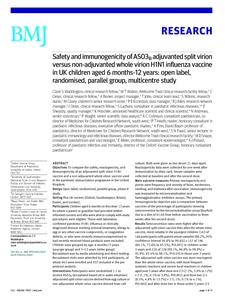Waddington, CS;
Walker, WT;
Oeser, C;
Reiner, A;
John, T;
Wilkins, S;
Casey, M;
Eccleston, PE;
Allen, RJ;
Okike, I;
et al.
Waddington, CS; Walker, WT; Oeser, C; Reiner, A; John, T; Wilkins, S; Casey, M; Eccleston, PE; Allen, RJ; Okike, I; Ladhani, S; Sheasby, E; Hoschler, K; Andrews, N; Waight, P; Collinson, AC; Heath, PT; Finn, A; Faust, SN; Snape, MD; Miller, E; Pollard, AJ
(2010)
Safety and immunogenicity of AS03(B) adjuvanted split virion versus non-adjuvanted whole virion H1N1 influenza vaccine in UK children aged 6 months-12 years: open label, randomised, parallel group, multicentre study.
BRITISH MEDICAL JOURNAL, 340 (c2649).
ISSN 1756-1833
https://doi.org/10.1136/bmj.c2649
SGUL Authors: Heath, Paul Trafford
![[img]](https://openaccess.sgul.ac.uk/200/1.hassmallThumbnailVersion/bmj.c2649.pdf)  Preview |
|
["document_typename_application/pdf; charset=binary" not defined]
Published Version
Download (165kB)
| Preview
|
Abstract
OBJECTIVES: To compare the safety, reactogenicity, and immunogenicity of an adjuvanted split virion H1N1 vaccine and a non-adjuvanted whole virion vaccine used in the pandemic immunisation programme in the United Kingdom.
DESIGN: Open label, randomised, parallel group, phase II study.
SETTING: Five UK centres (Oxford, Southampton, Bristol, Exeter, and London).
PARTICIPANTS: Children aged 6 months to less than 13 years for whom a parent or guardian had provided written informed consent and who were able to comply with study procedures were eligible. Those with laboratory confirmed pandemic H1N1 influenza or clinically diagnosed disease meriting antiviral treatment, allergy to egg or any other vaccine components, or coagulation defects, or who were severely immunocompromised or had recently received blood products were excluded. Children were grouped by age: 6 months-<3 years (younger group) and 3-<13 years (older group). Recruitment was by media advertising and direct mailing. Recruitment visits were attended by 949 participants, of whom 943 were enrolled and 937 included in the per protocol analysis.
INTERVENTIONS: Participants were randomised 1:1 to receive AS03(B) (tocopherol based oil in water emulsion) adjuvanted split virion vaccine derived from egg culture or non-adjuvanted whole virion vaccine derived from cell culture. Both were given as two doses 21 days apart. Reactogenicity data were collected for one week after immunisation by diary card. Serum samples were collected at baseline and after the second dose.
MAIN OUTCOME MEASURES: Primary reactogenicity end points were frequency and severity of fever, tenderness, swelling, and erythema after vaccination. Immunogenicity was measured by microneutralisation and haemagglutination inhibition assays. The primary immunogenicity objective was a comparison between vaccines of the percentage of participants showing seroconversion by the microneutralisation assay (fourfold rise to a titre of >or=1:40 from before vaccination to three weeks after the second dose).
RESULTS: Seroconversion rates were higher after the adjuvanted split virion vaccine than after the whole virion vaccine, most notably in the youngest children (163 of 166 participants with paired serum samples (98.2%, 95% confidence interval 94.8% to 99.6%) v 157 of 196 (80.1%, 73.8% to 85.5%), P<0.001) in children under 3 years and 226 of 228 (99.1%, 96.9% to 99.9%) v 95.9%, 92.4% to 98.1%, P=0.03) in those over 3 years). The adjuvanted split virion vaccine was more reactogenic than the whole virion vaccine, with more frequent systemic reactions and severe local reactions in children aged over 5 years after dose one (13 (7.2%, 3.9% to 12%) v 2 (1.1%, 0.1% to 3.9%), P<0.001) and dose two (15 (8.5%, 4.8% to 13.7%) v 2 (1.1%, 0.1% to 4.1%), P<0.002) and after dose two in those under 5 years (15 (5.9%, 3.3% to 9.6%) v 0 (0.0%, 0% to 1.4%), P<0.001). Dose two of the adjuvanted split virion vaccine was more reactogenic than dose one, especially for fever >or=38 masculineC in those aged under 5 (24 (8.9%, 5.8% to 12.9%) v 57 (22.4%, 17.5% to 28.1%), P<0.001).
CONCLUSIONS: In this first direct comparison of an AS03(B) adjuvanted split virion versus whole virion non-adjuvanted H1N1 vaccine, the adjuvanted vaccine, while more reactogenic, was more immunogenic and, importantly, achieved high seroconversion rates in children aged less than 3 years. This indicates the potential for improved immunogenicity of influenza vaccines in this age group.
| Item Type: |
Article
|
| Additional Information: |
© Waddington et al 2010. This is an open-access article distributed under the terms of the Creative Commons Attribution Non-commercial License, which permits use, distribution, and reproduction in any medium, provided the original work is properly cited, the use is non commercial and is otherwise in compliance with the license. |
| Keywords: |
Adjuvants, Immunologic, Adolescent, Child, Child, Preschool, Drug Combinations, Female, Hemagglutination Inhibition Tests, Humans, Infant, Influenza A Virus, H1N1 Subtype, Influenza Vaccines, Influenza, Human, Male, Polysorbates, Squalene, Virion, alpha-Tocopherol, Science & Technology, Life Sciences & Biomedicine, Medicine, General & Internal, General & Internal Medicine, PANDEMIC INFLUENZA, YOUNG-CHILDREN, CELL-CULTURE, TRIAL, VIRUS, RECOMMENDATIONS, RESPONSES, ANTIBODY, INFANTS |
| SGUL Research Institute / Research Centre: |
Academic Structure > Infection and Immunity Research Institute (INII) |
| Journal or Publication Title: |
BRITISH MEDICAL JOURNAL |
| ISSN: |
1756-1833 |
| Related URLs: |
|
| Web of Science ID: |
WOS:000278279600002 |
  |
Download EPMC Full text (PDF)
|
 |
Download EPMC Full text (HTML)
|
| URI: |
https://openaccess.sgul.ac.uk/id/eprint/200 |
| Publisher's version: |
https://doi.org/10.1136/bmj.c2649 |
Statistics
Item downloaded times since 30 Apr 2012.
Actions (login required)
 |
Edit Item |



